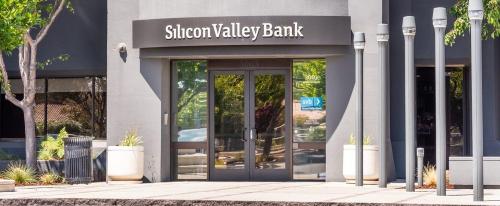This post was most recently updated on May 12, 2023.
What is deposit insurance?
Deposit insurance is the government’s guarantee that an account holder’s money at an insured bank is safe up to a certain amount, currently $250,000 per account. Deposit insurance is provided by the Federal Deposit Insurance Corporation (FDIC), a government agency that collects fees – insurance premiums – from banks. The FDIC is overseen by a five-member board – three nominated by the President and confirmed by the Senate, plus the Comptroller of the Currency and the director of the Consumer Financial Protection Bureau.
Deposit insurance, created during the Great Depression in 1933, has sharply reduced the frequency of bank runs that once were common in the U.S. As former Federal Reserve Chair Ben Bernanke explained in his 2022 Nobel Prize speech, about 40% of all U.S. banks disappeared between 1929 and 1933: “They failed, closed, or were absorbed by other banks. That happened because there were massive runs, bank runs, where people lost confidence in the banks and pulled out their money…The ones that were closed couldn’t make loans, obviously, and the ones that survived became extremely cautious being very reluctant to make loans.”
“Shortly after [Franklin Delano Roosevelt] became president, he called a bank holiday and all the banks had to shut down, and he promised the American public that they wouldn’t open up until the government had inspected them and was confident that they were in viable condition. And then the Congress passed deposit insurance, so that small depositors would be guaranteed that even if their bank failed, the government would pay them off. And that led instantaneously to a stabilization of the banking system. And that, of course, as the banking system became workable, that led to, helped lead to recovery.”
How much of an individual bank account is covered by insurance?
By law, up to $250,000 is insured for each depositor’s account in each bank. Congress raised the limit from $100,000 to $250,000 temporarily in 2008 and made the increase permanent in 2010. For most Americans, deposit insurance is more than enough to insure all money in their checking and savings accounts. However, businesses and other large organizations may hold over $250,000 at a given time. As of the end of 2022, about 43% of all bank deposits were uninsured, according to the FDIC.
How is the FDIC funded?
The FDIC receives no appropriation from Congress, although it is backed by the full faith and credit of the U.S. government. Instead, the agency is funded by insurance premiums paid by banks and from interest earned on the FDIC’s Deposit Insurance Fund, which is invested in U.S. government obligations. The banks’ premiums depend on the size of the bank and bank regulators’ assessment of the riskiness of the bank.
As of Dec. 31, 2022, the Deposit Insurance Fund had $128.2 billion, or about 1.27% of all insured deposits. The FDIC is gradually increasing premiums to bring the ratio up to the statutory minimum of 1.35% by September 30, 2028. Its target is to get the Fund up to 2% of insured deposits over the long run to “reach a level sufficient to withstand a future crisis.”
What does the FDIC do when a bank fails?
When a bank fails, the FDIC basically has two options. The first is to sell the bank to a willing buyer, which may take a portion or the entirety of the failed bank’s assets and liabilities. The second is to pay off the insured deposits and liquidate the failed bank’s assets, with uninsured depositors recuperating money based on the value of the assets. (To read FDIC Chair Martin Gruenberg’s description of this process, click here.)
When Washington Mutual failed in 2008 and was sold to JPMorgan Chase, uninsured depositors (who accounted for 24% of total deposits) got all their money. But when IndyMac failed, also in 2008, uninsured account holders recovered 50 percent of uninsured deposits. Even so, IndyMac was the costliest failure in the FDIC’s history – a $12.4 billion hit to the Deposit Insurance Fund. Since 1991, the FDIC has been required to choose the resolution method least costly to its Deposit Insurance Fund — unless the FDIC and other regulators declare that the least-cost option poses a systemic risk (see below).
On March 19, 2023, the FDIC said it sold substantially all the deposits, the branches, and some of the loans of failed Signature Bank to Flagstar Bank of Hicksville, New York. The FDIC estimated that cost of the failure to the Deposit Insurance Fund would be about $2.5 billion. And on March 23, the agency said it sold all the deposits and loans of Silicon Valley Bank – but not the bank’s portfolio of bonds and other securities – to First Citizens Bank & Trust of Raleigh, North Carolina. The FDIC estimated the deal will cost the Deposit Insurance Fund about $20 billion.
Why did depositors in Silicon Valley Bank and Signature Bank with more than $250,000 in their accounts get covered?
At times of acute financial stress, the law allows the government to lift the $250,000 ceiling. This is known as a “systemic risk exception.” If federal officials believe that normal procedures would have “serious adverse effects on economic conditions or financial stability,” a systemic risk exception can be declared by the Treasury Secretary, in consultation with the President, provided at least two-thirds of the members of the FDIC’s Board of Directors and two-thirds of the members of the Federal Reserve’s Board of Governors approve. The systemic risk exception was written into law in 1991 but wasn’t used until the Global Financial Crisis of 2008. In March 2023, Treasury Secretary Janet Yellen invoked the systemic risk exception to cover all deposits of Silicon Valley Bank and Signature Bank.
In May 2023, the FDIC proposed to cover its losses on SVB and Signature with an assessment of 0.125% a year for two years levied on large banks’ uninsured deposits, arguing that these banks benefited indirectly to decision to cover all uninsured deposits at the two failed banks. It would exempt the first $5 billion of uninsured deposits at any bank from the assessment. Only 113 of the more than 4,000 banks insured by the FDIC would be subject to the levy, including the nation’s largest banks. The FDIC estimated the special assessment would raise $15.8 billion.
What about depositors at other banks with more than $250,000?
Although the Treasury Secretary could invoke a “systemic risk exemption” to allow the FDIC to lift the deposit insurance ceiling for another bank, the Dodd-Frank law passed after the Global Financial Crisis says the FDIC can make an increase in the $250,000 limit “widely available” only with the approval of Congress. Following the Silicon Valley Bank failure, proposals to raise the ceiling began circulating in Congress, in the administration, and in some parts of the banking industry. A coalition of mid-sized banks, for instance, has asked regulators to extend insurance to all deposits for the next two years.
Questioned at a March 22 congressional hearing, Treasury Secretary Yellen said that the Treasury is not considering lifting the $250,000 deposit ceiling for all accounts. “All that I have said is that when the failure of a bank is judged by supermajorities of the FDIC board, the Fed board, and myself in consultation with the president… is deemed to create systemic risk, which I think of as the risk of a contagious bank run, that we are likely to invoke the systemic risk exception, which permits the FDIC to protect all depositors. And that would be a case by case determination. I have not considered or discussed anything having to do with blanket insurance or guarantees of all deposits.”
When First Republic Bank failed at the end of April 2023, the FDIC sold the bank’s deposits, branches, and most of its assets to JPMorgan Chase, a transaction which the FDIC estimated will cost its deposit insurance fund $13 billion. All of First Republic’s deposits, insured and uninsured, became deposits at JPMorgan Chase, so no depositors lost any money.
WHAT CHANGES TO DEPOSIT INSURANCE ARE UNDER CONSIDERATION?
In May 2023, the FDIC offered three options for deposit insurance reform:
- Maintain the current framework, but raise the limit from the current $250,000 per account.
- Extend unlimited deposit insurance to all depositors.
- Offer different deposit ceilings for different types of accounts with significantly higher ceilings on business payments accounts.
The FDIC said the third option (which it called “targeted coverage”) best meets the objectives of “financial stability and depositor protection relative to costs.”
Some of the participants in an April 2023 Hutchins Center debate on the merits of raising the ceiling on deposit insurance favor a higher ceiling on the bank accounts that small businesses use for payroll and other purposes. You can read highlights of that debate here.
The Brookings Institution is financed through the support of a diverse array of foundations, corporations, governments, individuals, as well as an endowment. A list of donors can be found in our annual reports published online here. The findings, interpretations, and conclusions in this report are solely those of its author(s) and are not influenced by any donation.









Commentary
How does deposit insurance work?
March 21, 2023